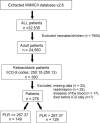Platelet-to-Lymphocyte Ratio: A Novel Prognostic Factor for Prediction of 90-day Outcomes in Critically Ill Patients With Diabetic Ketoacidosis
- PMID: 26825908
- PMCID: PMC5291578
- DOI: 10.1097/MD.0000000000002596
Platelet-to-Lymphocyte Ratio: A Novel Prognostic Factor for Prediction of 90-day Outcomes in Critically Ill Patients With Diabetic Ketoacidosis
Abstract
Diabetic ketoacidosis (DKA) is a life-threatening acute complication of diabetes mellitus and the novel systemic inflammation marker platelet-to-lymphocyte ratio (PLR) may be associated with clinical outcome in patients with DKA. This study aimed to investigate the utility of PLR in predicting 90-day clinical outcomes in patients with DKA. Patient data exacted from the Multiparameter Intelligent Monitoring in Intensive Care II (MIMIC II) database was analyzed. A cutoff value for PLR of 267.67 was determined using Youden index (P < 0.05) and used to categorize subjects into a high PLR group and a low PLR group. The hazard ratios (HRs) and 95% confidence intervals (CIs) for DKA were calculated across PLR. Clinical outcomes in our study were defined as intensive care unit (ICU) 90-day readmission and all-cause mortality. A total of 278 ICU admissions were enrolled and stratified by cutoff value of PLR. The incidence of readmission and mortality was 17.8% in the high PLR group, significantly higher than 7.4% in the low PLR group. In the multivariable model, after adjusting for known confounding variables including clinical parameters, comorbidities, laboratory parameters, the HRs for DKA were 2.573 (95% CI 1.239-5.345; P = 0.011), 2.648 (95% CI 1.269-5.527; P = 0.009), and 2.650 (95% CI 1.114-6.306; P = 0.028), respectively. The Kaplan-Meier survival curve showed that a high PLR level was associated with a higher risk for 90-day outcomes in patients with DKA. The authors report that higher PLR presents a higher risk for 90-day incidence of readmission and mortality in patients with DKA. It appears to be a novel independent predictor of 90-day outcomes in critically ill DKA patients in ICU units.
Conflict of interest statement
The authors have no conflicts of interest to disclose.
Figures


Similar articles
-
Association of the systemic immune-inflammation index (SII) and severity of diabetic ketoacidosis in patients with type 1 diabetes mellitus: a retrospective cohort study.Ann Med Surg (Lond). 2024 May 20;86(7):3865-3872. doi: 10.1097/MS9.0000000000002185. eCollection 2024 Jul. Ann Med Surg (Lond). 2024. PMID: 38989212 Free PMC article.
-
Prognostic value of platelet-to-lymphocyte ratios among critically ill patients with acute kidney injury.Crit Care. 2017 Sep 8;21(1):238. doi: 10.1186/s13054-017-1821-z. Crit Care. 2017. PMID: 28882170 Free PMC article.
-
Incidence and long-term outcomes of critically ill adult patients with moderate-to-severe diabetic ketoacidosis: retrospective matched cohort study.J Crit Care. 2014 Dec;29(6):971-7. doi: 10.1016/j.jcrc.2014.07.034. Epub 2014 Aug 16. J Crit Care. 2014. PMID: 25220529
-
Platelet count and platelet-lymphocyte ratio as prognostic markers for head and neck squamous cell carcinoma: Meta-analysis.Head Neck. 2018 Dec;40(12):2714-2723. doi: 10.1002/hed.25366. Epub 2018 Aug 13. Head Neck. 2018. PMID: 30102821
-
Role of platelet-to-lymphocyte count ratio (PLR), as a prognostic indicator in COVID-19: A systematic review and meta-analysis.J Med Virol. 2022 Jan;94(1):211-221. doi: 10.1002/jmv.27297. Epub 2021 Aug 31. J Med Virol. 2022. PMID: 34436785 Free PMC article.
Cited by
-
Platelet to lymphocyte ratio predicting 6-month primary patency of drug-coated balloon for femoropopliteal disease.BMC Cardiovasc Disord. 2020 Jan 9;20(1):9. doi: 10.1186/s12872-019-01314-1. BMC Cardiovasc Disord. 2020. PMID: 31918662 Free PMC article.
-
Usefulness of pre-thyroidectomy neutrophil-lymphocyte, platelet-lymphocyte, and monocyte-lymphocyte ratios for discriminating lymph node and distant metastases in differentiated thyroid cancer.Clinics (Sao Paulo). 2021 Aug 16;76:e3022. doi: 10.6061/clinics/2021/e3022. eCollection 2021. Clinics (Sao Paulo). 2021. PMID: 34406270 Free PMC article.
-
Association of the systemic immune-inflammation index (SII) and severity of diabetic ketoacidosis in patients with type 1 diabetes mellitus: a retrospective cohort study.Ann Med Surg (Lond). 2024 May 20;86(7):3865-3872. doi: 10.1097/MS9.0000000000002185. eCollection 2024 Jul. Ann Med Surg (Lond). 2024. PMID: 38989212 Free PMC article.
-
Characteristics and clinical relevance of leukocytic response in children with diabetic ketoacidosis - A comparative cohort study.Arch Endocrinol Metab. 2024 Jul 30;68:e230183. doi: 10.20945/2359-4292-2023-0183. eCollection 2024. Arch Endocrinol Metab. 2024. PMID: 39420911 Free PMC article.
-
Systemic Infection Predictive Value of Procalcitonin to Lactic Acid Ratio in Diabetes Ketoacidosis Patients.Diabetes Metab Syndr Obes. 2022 Jul 22;15:2127-2133. doi: 10.2147/DMSO.S371437. eCollection 2022. Diabetes Metab Syndr Obes. 2022. PMID: 35911501 Free PMC article.
References
-
- Misra S, Oliver N, Dornhorst A. Diabetic ketoacidosis: not always due to type 1 diabetes. Br Med J 2013; 346:f3501. - PubMed
-
- Kitabchi AE, Umpierrez GE, Murphy MB, et al. Management of hyperglycemic crises in patients with diabetes. Diabetes Care 2001; 24:131–153. - PubMed
-
- Abdulrahman GO, Amphlett B, Okosieme OE. Trends in hospital admissions with diabetic ketoacidosis in Wales, 1999-2010. Diabetes Res Clin Pract 2013; 100:e7–10. - PubMed
Publication types
MeSH terms
LinkOut - more resources
Full Text Sources
Other Literature Sources

